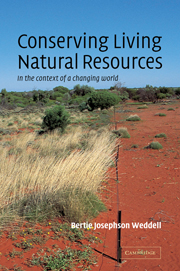Book contents
- Frontmatter
- Contents
- Preface
- Introduction: Balance and flux
- Methodology: Getting the information we need to manage living natural resources
- Part I Management to maximize production of featured species – a utilitarian approach to conservation
- Part II Protection and restoration of populations and habitats – a preservationist approach to conservation
- Part III Management to maintain processes and structures – a sustainable-ecosystem approach to conservation
- 11 Historical context – pressures to move beyond protection of species and reserves
- 12 Central concepts – the flux of nature
- 13 Techniques – conserving processes and contexts
- 14 Techniques – including people in the conservation process
- Postscript
- Appendix: Scientific names of organisms mentioned in the text
- Index
13 - Techniques – conserving processes and contexts
Published online by Cambridge University Press: 05 June 2012
- Frontmatter
- Contents
- Preface
- Introduction: Balance and flux
- Methodology: Getting the information we need to manage living natural resources
- Part I Management to maximize production of featured species – a utilitarian approach to conservation
- Part II Protection and restoration of populations and habitats – a preservationist approach to conservation
- Part III Management to maintain processes and structures – a sustainable-ecosystem approach to conservation
- 11 Historical context – pressures to move beyond protection of species and reserves
- 12 Central concepts – the flux of nature
- 13 Techniques – conserving processes and contexts
- 14 Techniques – including people in the conservation process
- Postscript
- Appendix: Scientific names of organisms mentioned in the text
- Index
Summary
In the last chapter we saw how ecologists have come to understand that ecosystem processes operate at multiple spatial and temporal scales, that patchiness is a crucial aspect of ecosystem structure and function, and that people have complex and often unappreciated effects on their resource base. In this and the following chapter, we will examine some applications of these concepts to management.
Ecologists' expanding understanding of ecosystems has focused attention on managing ecosystems in ways that maintain or restore critical processes and structures. The underlying hypothesis is that if critical functions and structures are maintained, ecosystems will continue to supply services and products that society needs, and this will allow for the long-term persistence of the species found in those ecosystems as well. The emphasis is less on producing specific products or protecting particular habitats and species and more on sustaining functioning ecosystems as a means of protecting both biodiversity and the resource base that fulfills people's needs. The ecosystems that result from this type of management are not simple; instead they are spatially heterogeneous and temporally variable. The resulting heterogeneity allows for greater species diversity. This type of management does not necessarily replace management that focuses on the needs of individual species, but it complements it.
The flux-of-nature perspective suggests that ecosystems should be viewed as dynamic and open and that by understanding how key components operate, managers can devise novel methods of manipulating ecosystems to protect biological diversity while meeting human needs.
- Type
- Chapter
- Information
- Conserving Living Natural ResourcesIn the Context of a Changing World, pp. 327 - 369Publisher: Cambridge University PressPrint publication year: 2002



